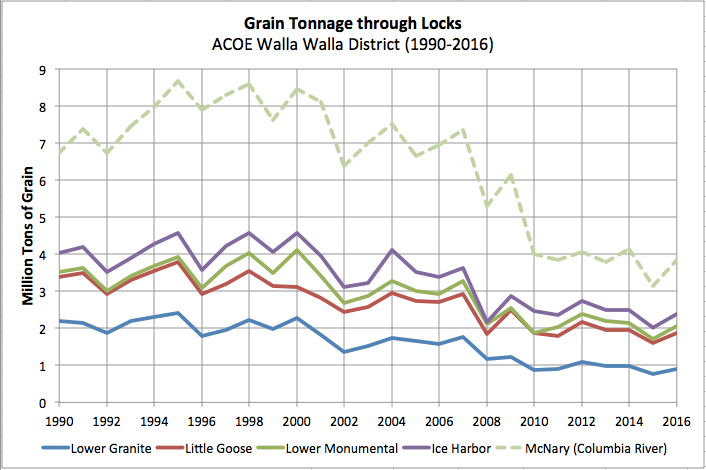forum
library
tutorial
contact

Wheat Growers Scheduled to
Meet with Gov. Inslee on Key Issues
by Rodney Harwood
Columbia Basin Herald, January 19, 2017
|
the film forum library tutorial contact |

|
Wheat Growers Scheduled to
by Rodney Harwood
|
Everyone benefits from our dams, and I will continue to
do my part in Congress to make sure they are supported.

OLYMPIA -- Members of the Washington Association of Wheat Growers will meet with more than 50 legislators and agency heads from both sides of the aisle.
The wheat growers will meet with Gov. Jay Inslee, legislators and agency staff during the association's annual Olympia Days.
"With budgets and funding on most legislators' minds, we need to make sure we are advocating for and protecting the Washington wheat industry's priorities, including retaining all food and farm-related tax incentives, and making sure that any clean air or clean water policies don't harm our ability to farm," said Ben Adams, president of the Washington Association of Wheat Growers and a wheat farmer from Douglas County.
The association's other priorities include protecting the Snake River dams and advocating for funding for Washington State University's new plant sciences building and animal health building on the university's Pullman campus.
"One of our top responsibilities is advocating for our growers' right to make a living growing a wheat crop," said Michelle Hennings, executive director of the Washington Association of Wheat Growers. "Every winter, our members take time away from their farms to meet face to face with legislators and tell their story. Sometimes, legislators don't understand how a bill or regulation discussed in Olympia will impact a farmer on the ground, especially if they are from a more urban district. By bringing farmers into a legislator's office, we can help them make that personal connection."
Education and outreach are the heart of Washington Association of Wheat Growers activity, all of which is aimed at helping Washington wheat families. Since 1954, WAWG has been dedicated to the enrichment of the Washington wheat industry as a nonprofit trade association, which depends on volunteers, membership dues and donations to carry out activities as representatives on the state and national levels. WAWG monitors state, transportation, research and natural resources policy.
Related Pages:
Our Dams Support Us; It's Time to Support Them by Cathy McMorris Rodgers, Capital Press, 12/1/16
Breaching Snake River Dams Would 'Devastate' Wheat Industry, Growers Say by Matthew Weaver, Capital Press, 11/20/16
There is more land planted to wheat in the world than any other crop.
It provides 20 percent of the world's caloric consumption.
A River of Wheat
Farmers in wheat growing areas of the country served only by the railroad are called "captive shippers" because they have no other way to get their wheat to market and transportation prices are correspondingly high. Washington farmers aren't captive because of the 360-mile long Snake/Columbia River system between Lewistion, Idaho and Portland Oregon. Barge traffic on the river is the most efficient - and cleanest -- frmm of transportation available. A tug pushing barges can haul a ton of wheat 576 miles on a single gallon of guel, compared to 413 miles by rail and 155 miles by truck. And tugs have one-third the emissions of rail and one-twentieth the emissions of truck, per ton-mile. An average of 60 percent of Washington wheat moves by barge to Portland. Two companies, Tidewater and Shaver, compete for farmers' barging business.
(bluefish notes: the US taxpayer pays for lock repairs and BPA electric rate payers lose energy when locks flush water otherwise used for power production. To say that barging is "most efficient" leaves out a substantial piece of the conversation.)
Wheat that makes waves
In 2014/2015 the United States exported nearly 835 million bushels of wheat to 68 countries around the world. That's almost 50 percent of the wheat produced in America. About 49 percent of U.S. wheat is exported from seven ports located in Washington and Oregon. Cargo ships known as bulk freighters transport 2.4 million bushels of wheat at a time to quality conscious customers in Asia, Latin America and North Africa. Smaller shipments of wheat leave the country in containers, those steel boxes used to transport goods around the world. Although a container only holds about 750 bushels of wheat, some buyers prefer smaller quantities of the highest quality wheat for specialized uses. Other millers in remote locations use containers because they also serve as convenient storage facilities.
White Wheat
Top Markets from USA
Country thousand metric tons thousand tons million bushels Japan 893.2 984.6 32.8 Phillipines 873.5 962.9 32.1 South Korea 523.8 577.4 19.2 Yemen 320.9 353.7 11.8 Indonesia 175.1 193.0 6.4 Thailand 171.4 188.7 6.3 Guatemala 141.3 155.8 5.2 Taiwan 120.1 132.4 4.4 Sri Lanka 109.4 120.6 4.0 Chile 80.9 89.2 3.0
Bells, Whistles and Wheat
BNSF, which dominates the rail shipping needs of Washington wheat farmers, has turned to shuttle train loading facilities as a more efficient method to move grain as inexpensively as possible. These facilities are set up to load 110 cars in 15 hours or less, and they move to market as a unit. Washington has four shuttle loading facilities. BNSF boasts a network of 233 shuttle loaders across the U.S., a 200 percent increase since 2000. Union Pacific, the other Class I railroad operating in Washington, does not have access to a shuttle train loading facility.
learn more on topics covered in the film
see the video
read the script
learn the songs
discussion forum
